Research Article - (2023) Volume 9, Issue 2
Received: 24-Feb-2023, Manuscript No. IPJDA-23-15768; Editor assigned: 27-Feb-2023, Pre QC No. IPJDA-23-15768 (PQ); Reviewed: 13-Mar-2023, QC No. IPJDA-23-15768; Revised: 24-Apr-2023, Manuscript No. IPJDA-23-15768 (R); Published: 01-May-2023, DOI: 10.36648/2471-853X.23.9.008
Background: As one of the primary causes of human suffering, the use of drugs like alcohol, khat, and tobacco has long been recognized. It is now considered to be one of the most important public health and socioeconomic challenges in the world. Even though it affects every aspect of society, youth substance misuse is disturbingly on the rise.
Objective: This study's goal is to evaluate how social drug usage affects students' academic performance, specifically among those who will graduate from civil service university in 2021.
Methodology: A cross-sectional study that was done on an institutional level among civil service university graduates. For the current study, a sample of 271 students was selected using a straightforward random selecting procedure from nine departments.
Result: A total of 271 graduating students from various departments were involved in this study. There were 97 women and 174 men overall or 64.2% and 35.8% respectively. 33.6% of people used social drugs at some point in their lives. According to this study, alcohol, khat, and cigarettes were the most widely used social drugs (41.8%, 40.7%, and 12.1% respectively). Increased absenteeism from class (31.9%) and a drop in cumulative grade point (27.5%) were the most frequent effects of social drug use on students' academic performances, followed by lack of interest in everyday activities (25.3%) and worsening academic performance (15.2%), according to respondents. The most common reasons reported by respondents were recreational purpose (25.6%), and peer pressure (23.3%) followed by for socialization (17.8%) and the least reasons were academic dissatisfaction (13.3%), to increase academic performance (11.1%) and loss of family control (8.9%). According to the statistical analysis and p-value, age, religion, ever social drug use, current social drug use, started using social drug use and impact of social drug use have statistically significant association with CGPA.
Conclusion and recommendation: According to the studies, social drug usage had a negative impact on kids' academic performance. The most common effects were more absence from school, a drop in cumulative grade point, and a lack of interest in everyday activities. Alcohol, khat, and cigarettes were the most popular social drugs. This finding justifies responsible bodies educating people about the detrimental effects that social drug use has on students' academic performance, especially when they first enroll in college, and it also calls for more thorough research that examine the various issues related to social drug use.
Social drug use; Impact; Educational performance; Socio-economic; Drunken driving
CGPAs: Cumulative Grade Point Averages; HIV: Human Immunodeficiency Virus; NACADA: National Agency for the Campaign Against Drug Abuse control of drug abuse; WHO: World Health Organization
One of the main causes of human suffering and one of the growing important public health and socio-economic concerns globally is the use of drugs and alcohol, including cigarettes, khat, and other drugs. Although substance use has an impact on every aspect of society, it is rising dangerously swiftly among younger people [1]. Substance abuse affects all facets of society, but it is particularly prevalent among college students. This leads to reduced productivity, poorer academic performance, a higher risk of contracting HIV and other STDs, accidents, drunken driving at the office, absenteeism, violent crime, theft, and psychiatric disorders like lethargy, hopelessness, and insomnia. Students at universities are a high risk demographic for participating in dangerous behaviors like smoking, binge drinking, and using illegal drugs. The beginning of substance use among college students is influenced by a number of factors. According to reports, peer pressure is one of the main causes of college students doing drugs, along with their newly acquired independence. The stress that students face as they adjust to their new environment is a third element that increases their risk of substance abuse and other risky behaviors [2-4]. Young people experience a variety of new sources of stress as they make the transition to college, including the separation from family, living in close quarters with strangers, the formation of new social groups, intense academic pressures, and juggling social obligations with academic and other responsibilities. Around 190 million people worldwide or 3.1% of the world's population or 4.3% of those who are 15 years of age or older, were drug users in 2006. According to a survey done among college students in Eldoret, Western Kenya, lifetime prevalence rates for all drug use were 69.8%, while those for alcohol and tobacco use were 51.9% and 42.8%, respectively. Substance use is one of the most burning and growing public health problems in Ethiopia, as in many developing countries; alcohol, khat and tobacco are the most frequently used substance. However, hard drugs such as heroin and cocaine are rarely used. In Ethiopia, khat is commonly used for stimulation and social recreation. A significant number of students consume khat to be alert and wakeful at night, especially during examination periods. Availability of substances, age, gender, having friends and families who use substances were the commonly mentioned factors that influence substances use.
Social drugs use and associated problems are of current global concern. It has become an epidemic in some parts of the African region with adolescents being the main victims of health problems due to substance addiction. The common substances abused in most African countries including Ethiopia are alcohol, khat and tobacco which are reported to be abused widely among students in colleges and high schools.
Khat contains substance that stimulates the CNS. The key constituent of khat responsible for its euphoric effect is called cathine or norseudoephedrine. Another compound with powerful CNS stimulant termed as cathinone (a-aminopropiophenone). Tobacco is one of the abused substances that could cause addiction the nicotine in cigarette smoke is known to have an addictive effect, so that they develop dependency and tolerance. Then this dependency exposed them to withdrawal symptoms such as restlessness, irritable behaviour, less able to concentrate if they try to stop abruptly. Smoking is currently considered one of the greatest problems in public health worldwide, and it is one of the most preventable causes of death.
Alcoholism is an international problem and had touched every corner of the world, both developed and developing countries. There is doubt that every country in the world, including Ethiopia incurs substantial cost as result of physical effects seen in sexual activity with excessive drinking is de generation and dysfunction of sex glands though small amount can lower inhibition and make the person more relaxed and more eager to engage in social and sexual activity. Impact of substance use on students: Some studies looked at the adverse impact of substance use. The identified problems included increased absenteeism from class, loss of interest in their daily activities, deterioration in their academic performance, manifesting as failure in examination or declines students CGPAs.
As literature revealed that psychoactive substance use became an urgent problems among undergraduate university students, with the most commonly used substances being alcohol, khat and cigarette. Most of the students started substance use during their preparatory school and first year university study period and the most commonly mentioned reason for khat, alcohol and cigarette use among university students were to keep alert while reading, for relaxation with friends and to get relief from stress respectively. Peer friends and family member substance use were identified to be the most significant factors for psychoactive substance use by the students. The aim of this study is to assess the social drug use and its impact on students’ educational performance. So there is no recent data in civil service university concerning social drug use and its impact on students’ educational performance by graduating students. And also this study will provide baseline data to further investigate. Moreover, the finding may call for attention of concerned bodies to make decision.
Study Area and Period
Civil service university found in Addis Ababa Ethiopia. Civil service university is public educational institution established in December 1993, located in center of Addis Ababa. Study periods from May 2021 August 2021.
Study Design
Institution based cross-sectional study design was conducted among graduating students at civil service university.
Populations
Source population: All regular; graduating students at civil service university will be source population.
Study population: Health science graduating class of 2021 students available during the study period and fulfilling eligibility criteria.
Inclusion and Exclusion Criteria
Health science graduating students attending their study in the year 2021 and willing to participate in the study was included. While, students who left the campus for practical attachments and who are critically sick during the study period were excluded.
Sampling Size and Sampling Technique
Sample size: The sample size for the study is determined by using the single population proportion formula:

Where,
z= Standard normal value at confidence interval of 95%= 1.96,
p=Prevalence estimate at 50%, q=1-p,
d= Margin of sampling error tolerated,
n= Minimum sample size required.
Therefore, the sample size is:

The total population is less than 10,000 we can use the following correctional formula:
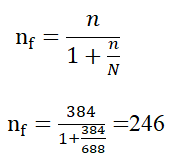
Where,
• nf=Final sample size,
• n=Sample size which is 384,
• N=Source of population which is 688.
By adding 10% of the non-respondent the actual sample size is 271 and the simple random sampling technique will be used for data collection [5].
Sampling Technique
Stratified sampling methods together with simple random sampling method were used to recruit samples for this study. The list of graduating students of civil service university was obtained from the university registrar. Students were stratified based on their department. Then, samples were elected proportionally from each department. Finally simple random sampling method was used to select samples from each department.
Study Variables
Independent variable: Age, sex, religion, ethnicity, monthly income, family occupation, field of study, and social drug use.
Dependent variable: The dependent variable was student’s performance.
Data Collection Instrument and Techniques
A questionnaire and supplemental supplies, including a pen, pencil, eraser, and sharpener, were utilized to gather the data. Data were gathered using a pretested structured, self-administered questionnaire. The questionnaire's first portion allows researchers to learn about the sociodemographic characteristics of the students, while the sections that follow ask questions crucial for identifying the most popular social drugs and determining how they affect academic performance. The lead investigator verified that every question on the questionnaire was answered fully and completely. Every day, the acquired data was appropriately handled, evaluated, and reviewed for accuracy and consistency of answers [6-8].
Socio-Demographic Characteristics
Out of 271 participants, 174 (64.2%) were male and the rest 97 (35.8%) were females. the age range of participants 24-29 years were 170 (62.7) and 18-23 were 101 (37.2%). The religious status of respondents showed that the majority 93 (36.2%) of them were orthodox followed by 83 (31.4%) Muslims while the catholic were 14 (5.2%) which is the least. From the total participants majority 119 (43.8%) were Oromo; 62 (23.6%) followed by 32 (11.7%) were Amhara while the Tiger were 7 (2.2%) which is the least [9].
Monthly income status of the study respondents showed that the majority 80 (29.5%) of their monthly income were 3000 followed by 79 (29.2%) were >500 while <1000 were 38 (14%) is the least. family job status showed that majorities of family job were 95 (35.1%) farmer followed by 85 (31.4%), 62 (22.9%) government employer, 18 (6.4%) while NGO were 11 (4.1%) which is the least. Department status of the study participant showed that 106 (39.1%) medicine, 34 (12.2%) nurse, 30 (11.1%) pharmacy, 27 (10%) medical laboratory, 19 (7%) HO, 18 (6.6%) midwifery, 16 (5.9%) environmental health, 11 (4.1%) dental medicine and 10 (3.7%) respectively (Table 1).
| Variables | Frequency | Percent | P-Value | |
|---|---|---|---|---|
| Sex | Male | 174 | 64.2 | 0.42 |
| Female | 97 | 35.8 | ||
| Age | 18-23 | 101 | 37.3 | 0.041 |
| 24-29 | 170 | 62.7 | ||
| Religion | Orthodox | 98 | 36.2 | 0.02 |
| Muslim | 85 | 31.4 | ||
| Protestant | 64 | 23.6 | ||
| Catholic | 14 | 5.2 | ||
| Others | 10 | 3.7 | ||
| Ethnicity | Oromo | 119 | 43.9 | 0.61 |
| Amara | 64 | 23.6 | ||
| Gurage | 32 | 11.8 | ||
| Tigre | 7 | 2.6 | ||
| Others | 49 | 18.1 | ||
| Monthly income | <1000 | 38 | 14 | 0.77 |
| 1000 | 74 | 27.3 | ||
| 3000 | 80 | 29.5 | ||
| >5000 | 79 | 29.2 | ||
| Family’s job | Farmer | 95 | 35.1 | 0.208 |
| Trader | 85 | 31.4 | ||
| Government employer | 62 | 22.9 | ||
| NGO | 18 | 6.4 | ||
| Others | 11 | 4.1 | ||
| Department | Anaesthesia | 10 | 3.7 | 0.94 |
| Dental medicine | 11 | 4.1 | ||
| Environmental health | 16 | 5.9 | ||
| HO | 19 | 7 | ||
| Medical laboratory | 27 | 10 | ||
| Medicine | 106 | 39.1 | ||
| Midwifery | 18 | 6.6 | ||
| Nurse | 34 | 12.5 | ||
| Pharmacy | 30 | 11.1 | ||
Table 1: Socio-demographic characteristics of graduating class students of civil service university, 2021.
Prevalence of Social Drugs Use
The study revealed that out of 271 respondents, 91 (33.6%) were used social drug at least once in their life time, 91 (33.6%) used in a last 12 months and 264 (92.3%) were current social drug users (Figure 1).
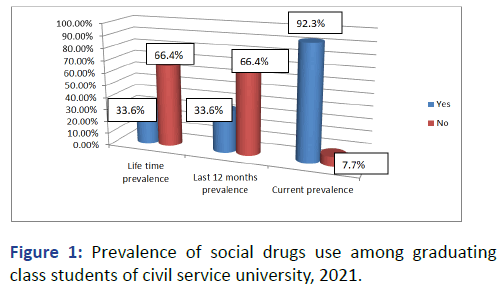
Figure 1: Prevalence of social drugs use among graduating class students of civil service university, 2021.
Commonly Used Social Drugs
The study show that the most commonly used social drugs in the last 12 months were alcohol 38 (41.8%), khat 37 (40.7%) and cigarette 11 (12.1%) respectively and currently used social drug were alcohol 43 (50.6%), khat 29 (34.1%) and cigarette 10 (11.8%) respectively (Figure 2).
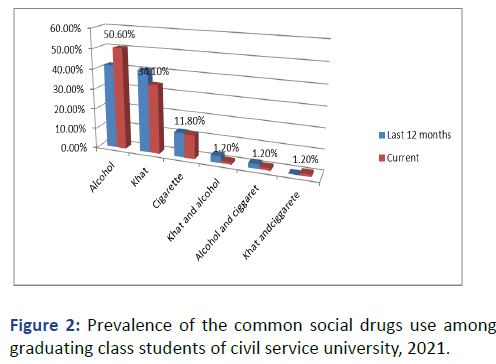
Figure 2: Prevalence of the common social drugs use among graduating class students of civil service university, 2021.
Pattern of Social Drug Used
Out of 271 study participants who have used social drug were 91; out of 91 study participant pattern of social drug status showed that 33 (36.3%) were weekly, 32 (35.2%) daily, 20 (22%) were occasionally, 4 (4.2%) monthly and 2 (2.2%) were every two weeks respectively (Table 2).
| Variables | Frequency | Percent | P-value |
|---|---|---|---|
| Daily | 32 | 35.20% | 0.165 |
| weekly | 33 | 36.30% | |
| Every two weeks | 2 | 2.20% | |
| Occasionally | 20 | 22% | |
| Monthly | 4 | 4.40% |
Table 2: Pattern of social drug used among graduating class students of civil service university, 2021.
Duration of Social Drug Used
Out of 271 study participant who have used social drug were 91; out 91 study participant, duration of social drug used status showed that 33 (36.3%) of them were used >4 years, 23 (25.3%) were 3-4 years, 22 (24.2%) were 1-2 years and 13 (14.3%) of them were use <1 year (Table 3) [10].
| Variables | Frequency | Percent | P-value |
|---|---|---|---|
| <1 year | 13 | 14.30% | 0.76 |
| 1-2 years | 22 | 24.20% | |
| 3-4 years | 23 | 25.30% | |
| >4 years | 33 | 36.30% |
Table 3: Duration of social drug used since started among; graduating class students of civil service university, 2021.
Started Using Social Drugs
Out of 271 study participant who have used social drug were 91 (100%) social drug started status showed that 55 (60.4%) of them were during university, 26 (28.6%) of them were during secondary, 8 (8.8%) of them were during elementary education and 2 (2.2%) (Table 4).
| Variables | Frequency | Percent | P-value |
|---|---|---|---|
| During childhood | 2 | 2.20% | 0.04 |
| During secondary | 26 | 28.60% | |
| During elementary education | 8 | 8.80% | |
| During university | 55 | 60.40% |
Table 4: When started using social drug use among graduating class students of civil service university, 2021.
Social Drug Started Year at University
Out of 271 study participant who have used social drug were 55 (20.29%) were started social drug use at university level, social drug started year at university status showed that 16 (29.1%) of them were started social drug use at first year, 13 (23.6%) third year, 12 (21.8%) were at first year, 9 (16.4%) final year, 3 (5.5%) fourth year and 2 (3.6%) were fifth year (Table 5).
| Variables | Frequency | Percent | P-value |
|---|---|---|---|
| First year | 12 | 21.80% | 0.075 |
| Second year | 16 | 29.10% | |
| Third year | 13 | 23.60% | |
| Fourth year | 3 | 5.50% | |
| Fifth year | 2 | 3.60% | |
| Final year | 9 | 16.40% |
Table 5: At which year social drug use started after joining university among; graduating class students of Civil Service University, 2021.
Reason for Social Drug Use
The most reason mentioned for use of social drug were 23 (25.6%) were for recreational purpose, 21 (23.3%) were due to peer pressure, 16 (17.8%) were for socialization, 12 (13.3%) were due to academic dissatisfaction, 10 (11.1%) were to increase academic performance and 8 (8.9%) loss of family control (Figure 3).
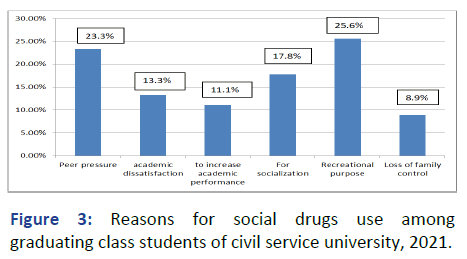
Figure 3: Reasons for social drugs use among graduating class students of civil service university, 2021.
The Effect of Social Drug after Using
Out of 91 study participant; the effect of social drug after using status showed that 37 (40.7%) were disturbance, 30 (33%) depression, 18 (19.8%) loss of appetite and 6 (6.6%) were others (Figure 4).
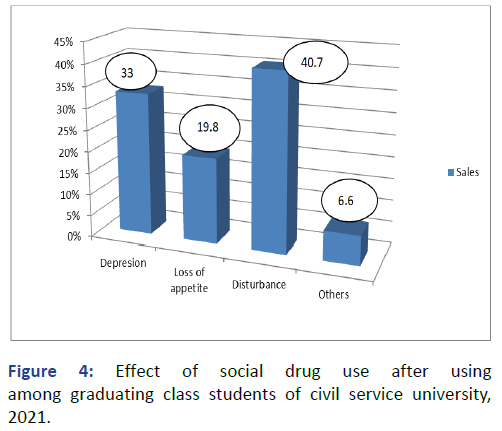
Figure 4: Effect of social drug use after using among graduating class students of civil service university, 2021.
Impact of Social Drug Use on Educational Performance
The most common impact of social drug use on educational performance were 29 (31.9%) increase absenteeism from class, 25 (27.5%) were decline cumulative grade point, 23 (25.3%) loss of interest in daily activities and 14 (15.4%) deterioration in your academic performance.
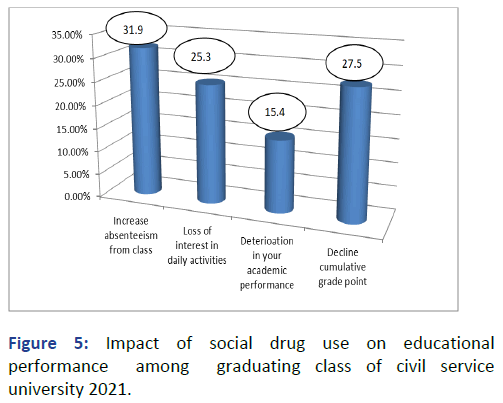
Figure 5: Impact of social drug use on educational performance among graduating class of civil service university 2021.
Educational Performance
Concerning, educational performance, 146 (53.9%) of students were promoted to their next level. While, 125 (46.1%) scored great distinction (Table 6).
| Variables | Have you ever use social drug? | Total | P-value | ||
|---|---|---|---|---|---|
| No | Yes | ||||
| CGPA category | Promoted | 74 | 72 | 146 | 0 |
| Great distinction | 106 | 19 | 125 | ||
| Total | 180 | 91 | 271 | ||
Table 6: Category students grade status among graduating class students of civil service university, 2021.
The test of significance was done between the CGPA or educational performance which is dependent variables and the factor affecting dependent variables which are the independent variables by chi-square and p-value. According to the statistical analysis and p-value, age (p<0.05), religion (p<0.05), ever social drug use (p<0.05), current social drug use (p<0.05), started using social drug use and impact of social drug use (p<0.05) have statistically significant association with CGPA (Table 7).
| Independent variables | Chi-square | Dependent variables (CGP) (df) | P-value |
|---|---|---|---|
| Age | 3.491 | 1 | 0.041 |
| Religion | 11.627 | 4 | 0.02 |
| Ever social drug use | 35.141 | 1 | 0 |
| Current social drug use | 11.73 | 1 | 0.004 |
| Started using social drug use | 13.3 | 3 | 0.004 |
| Impact of social drug use | 11.687 | 3 | 0.009 |
Table 7: The significance association between the independent variables and CGPA among graduating class of civil service university, 2021.
This study evaluated the social usage of drugs and how it affected students' academic performance. A total of 271 graduating students from various departments were involved in this study. There were 97 women and 174 men overall, or 64.2% and 35.8% respectively. According to the operational definition used in this study, substance users are defined as students who have used at least one social drug in their lifetime. As a result, 33.6% of adults reported using social drugs in their lifetime. This is less than the research done at Hawasa university (53.6%) and Debremarkos polytechnic college (61.7%). The study's claimed decreased prevalence could have been caused by the limited sample size [11].
The prevalence of social drugs in last 12 months was 33.6% which is lower than study reported in Hawassa university (45.7%). The current prevalence of social drugs in the present study was 92.3% which is greater than study reported in Debremarkos polytechnique college (38%). The low prevalence of last 12 months due to the respondents’ answer were the same as life time prevalence. High current prevalence in this study was probably due to differences in study area.
According to this study the most commonly used social drugs were alcohol, khat and cigarette (41.8%, 40.7% and 12.1% respectively) which was higher than studies conducted in Axum university (34.5%, 28.7% and 9.5% respectively) and university of Gondor (41%, 24% and 4% respectively). This might be due to respondents who use social drugs at least once in their life included as drug users. Alcohol was lower than study conducted in Kenyatta university (92.1%). This might be due to different in study setting, availability and cost of social drugs. The prevalence of alcohol was high. This might be due to most khat chewer need alcohol to reduce stimulant effect of khat or for ‘chabsi,’ most of the respondents were orthodox which use alcohol than other social drugs and most respondents’ drink alcohol to celebrate holiday. The prevalence of khat (40.7%) was also high when compared with studies conducted in university of Gondor (24%) and Axum university (28.8%). This probably due to khat is used mostly during examination time for reading to increase performance. The low prevalence of cigarette smoking (12%) when compared alcohol (41.8%) and khat (40.7%) probable due to of fear of bad odour of tobacco and easily identified by other students, cigarette smoking disadvantage are disseminated by media as well as cigarette not related with increasing academic performance and for special celebrations of holiday unlike khat and alcohol.
The most common impact of social drug use on student educational performances reported by respondent were increase absenteeism from class (31.9%) and decline cumulative grade point (27.5%) followed by loss of interest in daily activities (25.3%) and the least impact were deterioration in your academic performance (15.2%). In Kenya, public secondary school of Nyamire North sub-country, indiscipline (21.9%), missed class (20.2%), affected students had low concentration span (19.7%), perform poorly in exam (19.6) and do not do assignment (18.6%). In this study increase absenteeism from class (31.9) and decline cumulative grade point (27.5%) were higher than Nyamire secondary school (20.2%, 19.6%) respectively. This difference might be due to most commonly used social drug in this study were alcohol because of this student missed class due to hangover, difference in study area and sleep disturbance.
The most common reasons reported by respondents were recreational purpose (25.6%), peer pressure (23.3%) followed by for socialization (17.8%) and the least reasons were academic dissatisfaction (13.3%), to increase academic performance (11.1%) and loss of family control (8.9%). These reasons similar with report showed in university of Gondar (for relaxation (29.1%), increase academic performance (14.7%), peer pressure (12.4%), for socialization (9.1%), to kill extra times (6.1 %), academic dissatisfaction and loss of family control) and Axum university common reason reported by study (to keep alert, for relaxation and relief from stress. The similarity might be due to students need social drugs for similar purpose. The high prevalence of peer influence might be most students celebrate holiday mostly related with alcohol and for socialization mostly related with khat and alcohol. The low occurrence of loss of family control may be connected to pupils who are older than 18 and are able to make their own decisions. Age, religion, ever social drug use, current social drug use, started using social drug use, and Impact of Social Drug Use show statistically significant associations with CGPA, according to statistical analysis and pvalue [9-11].
A quarter of civil service university graduates were discovered to utilize social drugs, according to research. Social drug use and academic achievement are strongly correlated. Alcohol, khat, and cigarettes were found to be the most frequently utilized social drugs in this study. Peer pressure, recreation, and sociability were the three most frequent justifications for using drugs in a social setting. Furthermore, depression and disturbance are the results of social drug usage. The spread of knowledge concerning the detrimental effects of social drug usage on students' academic performance should be prioritized, especially when new students first enroll in college. University need to monitor and teach their students about impact of social drug use on educational performance and health risk. Parents should be more concerned with negative impact against their children. The government should give priority for rehabilitation center. Working hard on preventive advertisements. Building strong youth network at school level that work on the issue of drug use and establishing anti-drug clubs and youth association. Further research should be conducted and disseminated to concerned bodies.
Formal permission letter was written from school of pharmacy, college of health and medical science. All respondents were informed about the objective of the study and their verbal consent was obtained. Additionally, confidentiality and privacy of the information were seriously respected.
[Crossref] [Google Scholar] [PubMed]
[Crossref] [Google Scholar] [PubMed]
[Crossref] [Google Scholar] [PubMed]
[Crossref] [Google Scholar] [PubMed]
Citation: Dengela TA, Demissie BS (2023) Civil Service University's Graduate Students Academic Performance and Social Drug Use, Addis Ababa, Ethiopia. J Drug Abuse. 9:008.
Copyright: © 2023 Dengela TA, et al. This is an open-access article distributed under the terms of the Creative Commons Attribution License, which permits unrestricted use, distribution, and reproduction in any medium, provided the original author and source are credited.